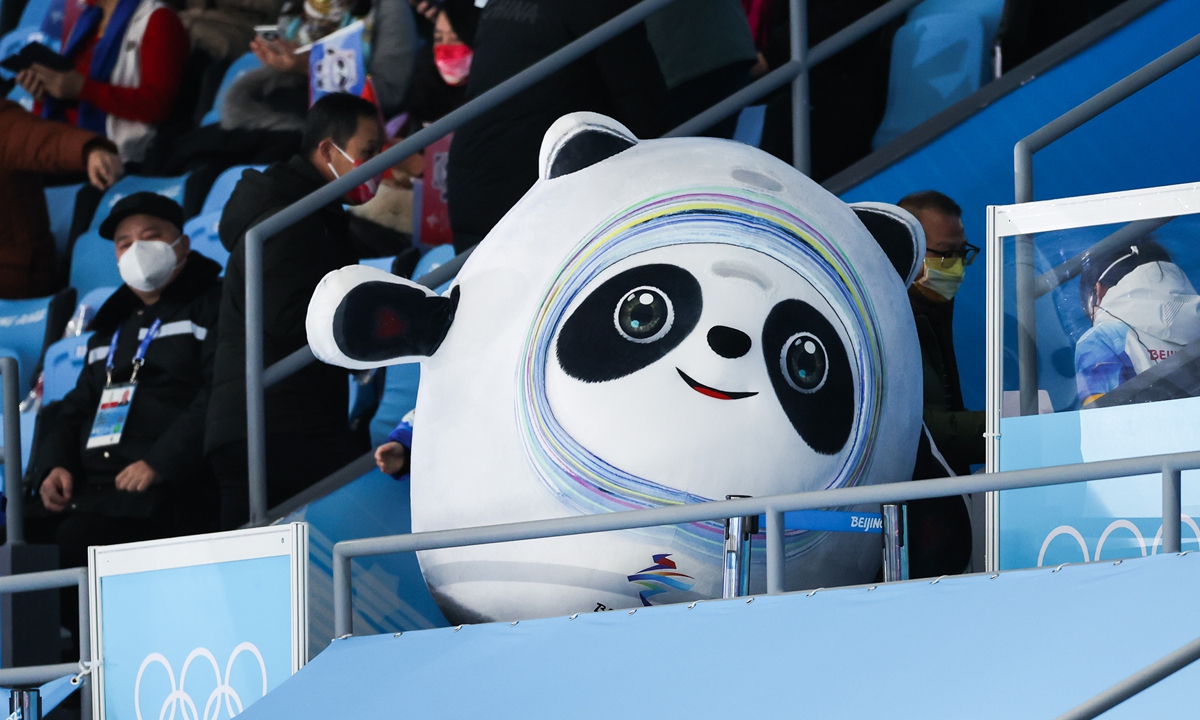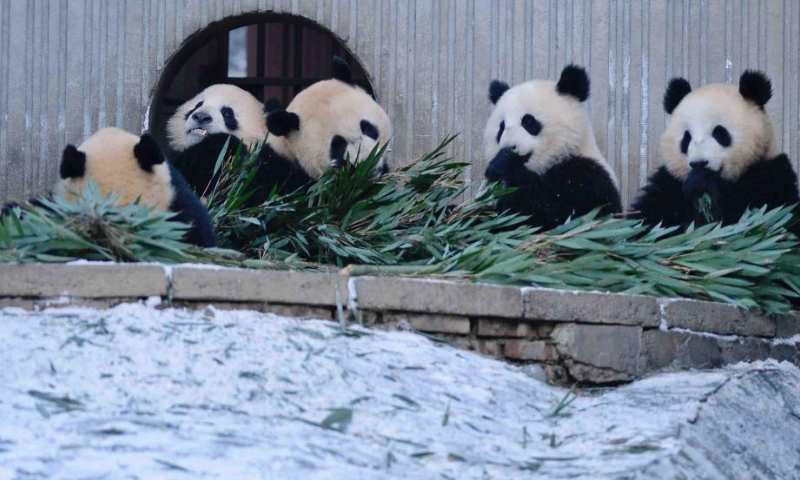People-to-people interaction at Beijing 2022 defies false narratives
Former US president Richard Nixon, a Republican, made a historic trip to China in 1972, unveiling a new page for US-China relations. But 50 years later, more Republicans take China as a threat with an ideology-centered perspective, as some even began manipulating the symbols of peace and love like the panda and long-term giant panda cooperation research, and breeding programs between China and zoos overseas have now become a new target for the anti-China campaign. The trend reflects a failing country and hysteria of some US politicians, Chinese experts said.
By combining the latest panda bill introduced by Republican Nancy Mace with a decades-long tradition between China and the US in terms of offering pandas as a gesture of friendship, the New York Times ran an article on Sunday questioning whether it’s time to change such a tradition, with so-called experts saying that pandas are seen as a way of “softening China’s authoritarian image.”
Citing experts, the US media outlet claimed that “China’s approach to panda diplomacy has shifted,” as the panda’s survival outlook has improved, and pandas come to “serve more of a shield for China’s human rights abuses and a tool to project soft power.”
However, Chinese experts on pandas, zoos overseas and observers refuted the claim, calling it narrow-minded, groundless and even ridiculous, as China’s panda “on-loan” practice is not only a diplomatic tradition but also a means of scientific cooperation across the world to preserve the common treasure.
And the extension of the giant panda agreement also facilitates further research in various sectors such as restoring the panda habitat and assessing the climate change impact, they added.

Bing Dwen Dwen Photo: VCG
Meanwhile, a researcher at the US-funded Australia-based think tank Australian Strategic Policy Institute also took it to the Beijing 2022 Winter Olympics mascot Bing Dwen Dwen – a playful panda wearing an icy shell – and used it as a tool in criticizing the Chinese “propaganda and information operations.”
However, a growing number of stories about warm and friendly people-to-people interactions, especially among athletes and volunteers during the Winter Games, formed a sharp contrast with those think tanks, US politicians and media-driven narratives about China. Some stories served as a vivid rebuttal against the long-standing lies about China fueled by US media and politicians, some observers said.
Joint efforts
Before 1982, giant pandas were given away to other countries by the Chinese government as a token of friendship and goodwill, according to open documents. For instance, two giant pandas were given to the US as gifts after former US president Richard Nixon visited China in 1972.
Before 1982, China practiced the policy of giving pandas as presents to other countries but after assessing the number of pandas in the late 1970s, China found that the animals were rare and endangered species, and considering the diplomatic factors, it’s impossible to give pandas endlessly. So China put an end to the “give-away” policy and stopped presenting the national treasure as a gift in 1982, Zhao Songsheng, manager of YueWeiLai, a Chengdu-based NGO on protecting giant pandas, told the Global Times on Monday.
The “on-loan” policy then started with a focus on pursuing cooperation on conservation of the rare animals with zoos around the world.
The pandas are then offered on loan usually on a 10-year term from China to some countries, and the “on-loan” program usually highlights close partnerships and scientific cooperation between China and other countries.
China has conducted cooperative research on giant panda conservation with 22 zoos in 18 countries, spokesperson of China’s foreign ministry Hua Chunying said at the press conference in February 2021.
When the giant panda Huan Huan, on loan to the Beauval Zoo in France, in 2021, gave birth, Chinese panda experts from the Chengdu Research Base of Giant Panda Breeding went to France to help the panda give birth to cubs. Also, Chinese experts offered remote instructions to their counterparts in the Japanese theme park Adventure World in Shirahama, Wakayama, in November 2020, to provide guidance during pandas’ mating, gestation and birth.
When the Smithsonian’s National Zoo and the China Wildlife Conservation Association extended their giant panda research agreement by the end of 2020 for three years, Steve Monfort, John and Adrienne Mars Director of the Smithsonian’s National Zoo and Conservation Biology Institute, said in a statement that through the power of science and cooperation, and with the support of the public and benefactors, the work on behalf of this beloved bear species continues.
For decades, the panda loan has been part of people-to-people interactions between the US and China. “China can send a pair of healthy and capable giant pandas to other countries for a 10-year cooperative research term, during which the bred offspring are owned by China, which is the practice universally recognized and supported,” Zhao said.
In the latest bill, the US Republican said pandas born in the US should not have to be returned to China. Such a proposal not only goes against the long-term established agreements in animal protection and scientific cooperation but further exposed the anti-China tactics played by some US politicians, experts said.
Actions speak louder than words
“From the latest panda bill, you can tell some anti-China politicians in the US have been doing whatever they can to smear images related to China, even with those lovable and positive symbols,” Li Haidong, a professor from the Institute of International Relations of China Foreign Affairs University, told the Global Times on Monday.
As a symbol of peace and love, the panda can now be used to attack China, connecting it to human rights issues, and used as a tool to advance Washington’s anti-China policies, echoing all-out efforts by US politicians to slander China’s image, Li noted.
However, such a hysterical mindset by some US politicians has little impact on the true people-to-people interactions between China and the US, especially at the Beijing 2022 Winter Olympics that serve as a bridge of solidarity and mutual understanding.
US freestyle skiing athlete Aaron Blunck said during his latest briefing that China has done a “stellar job” with COVID-19 protocols for the Winter Olympics, adding that “being stateside you heard some pretty bad media (regarding COVID) and that is completely false.”
In addition, the touching moments between US snowboarder Tessa Maud and a Chinese volunteer as well as her genuine affection for China have been trending on Chinese social media for days, applauded by many Chinese netizens. And all those examples made those tactics of slandering and smearing China’s image even trivial, experts said.
“Driven by long-term biased ideology, Mace has been facing in-party pressure in the upcoming midterm elections. As she had also manipulated the Taiwan question last year, the Republican was eager to politicize more China-related topics to gain political scores,” Diao Daming, an associate professor at the Renmin University of China in Beijing, told the Global Times on Monday.
As China and the US will soon celebrate the 50th anniversary of Nixon’s trip to China, such tactics, which go against people’s hearts and the people-to-people interactions between the two countries, exposed the dilemma and difficulties in China-US relations, Diao said, noting that such a challenging situation, caused by certain US politicians, needs a deeper reflection by Washington.
Giant pandas eat at the snow-covered Shenshuping base of the China Conservation and Research Center for Giant Panda in Wolong, southwest China’s Sichuan Province, Feb. 9, 2022. (Xinhua)




